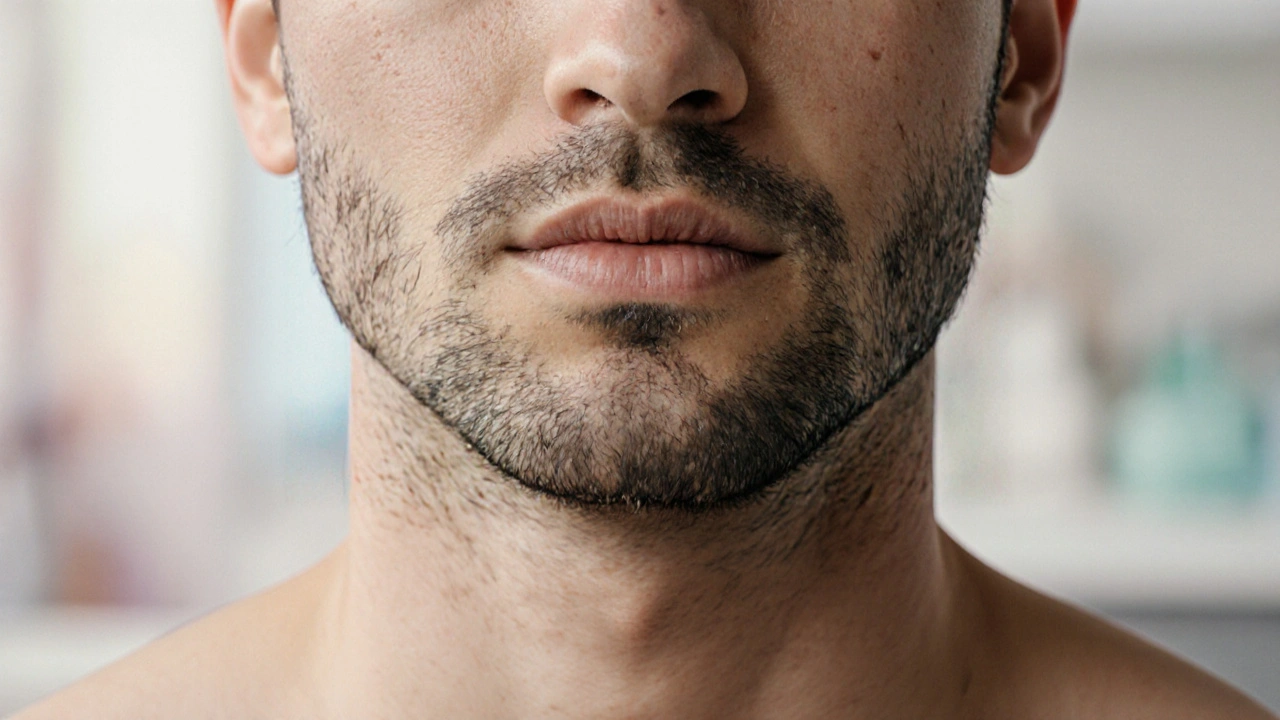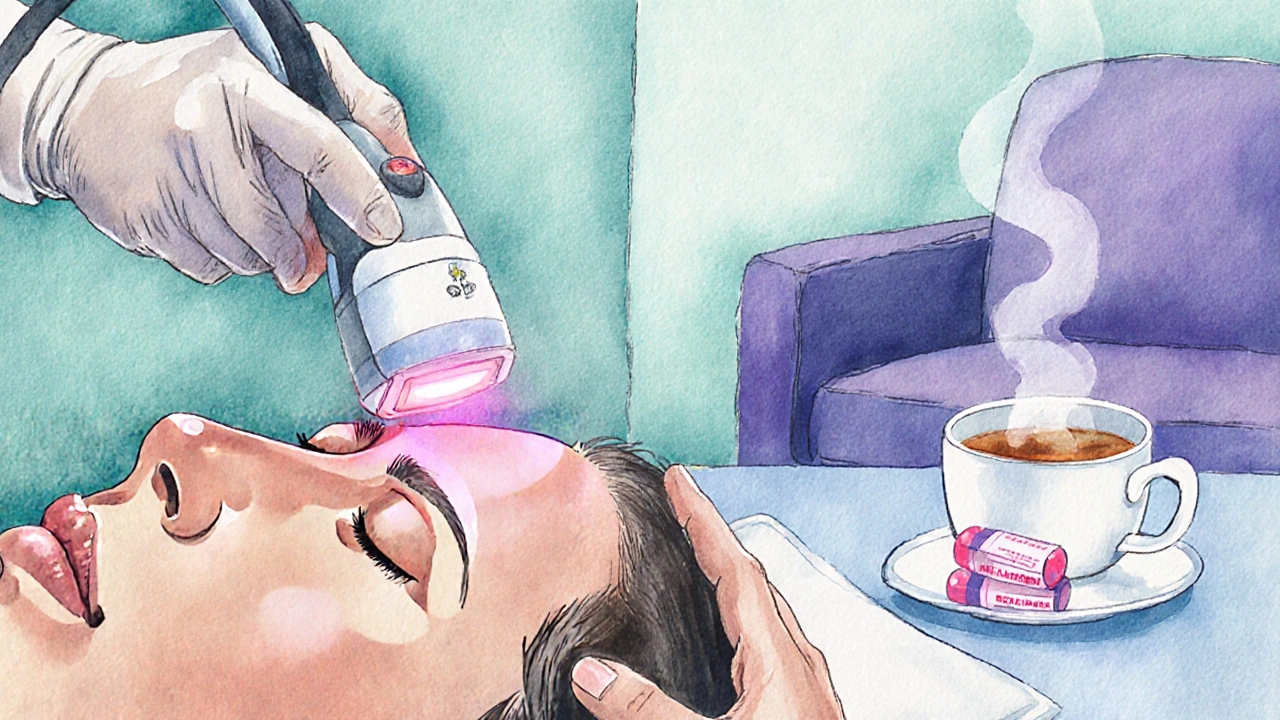Hirsutism & Gender Identity: Essential Guide for Transgender People
 Oct, 11 2025
Oct, 11 2025
Hirsutism Assessment Calculator
What is this tool?
This calculator helps you estimate your Ferriman-Gallwey score, a standard method for assessing hirsutism. The tool is for educational purposes only and should not replace professional medical advice.
How it works: Rate hair growth on 9 body areas. Each area is scored 0-4 based on hair density. Total score above 8 typically indicates hirsutism.
Hirsutism Assessment
Important Note: This tool is for educational purposes only. A Ferriman-Gallwey score above 8-10 generally indicates hirsutism, but personal and cultural factors influence perceived severity. Please consult with a healthcare professional for medical advice.
Hirsutism is excessive, male‑pattern hair growth in areas where women and gender‑diverse people typically have fine or no hair. While the condition is often discussed in the context of cisgender women, many transgender individuals encounter unique challenges because of hormone therapy, gender‑affirming surgeries, and social expectations. Understanding the biology, treatment options, and mental‑health impact can help you make informed choices and feel more comfortable in your body.
Key Takeaways
- Hirsutism is driven by androgen levels, which can be altered by gender‑affirming hormone therapy.
- Both trans men and trans women may experience unwanted hair growth, but the causes and solutions differ.
- Medical treatments (anti‑androgens, dose adjustments) work alongside cosmetic options (laser, electrolysis).
- Open communication with endocrinologists and dermatologists is essential for safe, effective care.
- Addressing mental‑health impacts early can prevent anxiety, dysphoria, and social isolation.
What Exactly Is Hirsutism?
In simple terms, hirsutism is the development of coarse, pigmented hair on the face, chest, abdomen, or back-areas that typically grow fine vellus hair in people assigned female at birth. The condition is usually quantified by the Ferriman‑Gallwey scoring system, which rates hair density across nine body sites. A score above 8‑10 generally indicates hirsutism, though personal and cultural factors influence perceived severity.
Root causes include:
- Elevated circulating androgen levels (testosterone, DHT).
- Increased sensitivity of hair follicles to normal androgen levels.
- Underlying endocrine disorders such as polycystic ovary syndrome (PCOS) or adrenal hyperplasia.
How Gender‑Affirming Hormone Therapy Interacts with Hair Growth
For many trans people, hormone therapy is a cornerstone of gender affirmation. The same hormones that help develop secondary sex characteristics can also trigger or suppress hair growth, depending on the regimen.
Trans Men (Assigned Female at Birth)
Typical regimens include testosterone (injectable, gel, or patch). Testosterone promotes:
- Deepening of the voice.
- Increase in muscle mass.
- Growth of facial, chest, and body hair.
Trans Women (Assigned Male at Birth)
Estrogen combined with anti‑androgens (e.g., spironolactone, cyproterone acetate, or GnRH agonists) aims to soften skin, reduce muscle mass, and slow hair growth. However, pre‑existing androgenic hair often persists for years, and complete removal is rare without additional interventions.
Key points:
- Anti‑androgens can lower circulating testosterone by 60‑80% but rarely eliminate it.
- High‑dose estrogen may cause skin thinning, making cosmetic hair removal more comfortable.
- Some trans women choose partial testosterone suppression to avoid severe side effects while still reducing hair growth.

Common Triggers of Unwanted Hair Growth in Trans People
Aside from the planned effects of hormone therapy, several factors can unexpectedly increase hair growth:
- Improper dosing: Over‑titrating testosterone in trans men can cause rapid, thick facial hair that may be difficult to manage.
- Medication interactions: Certain psychiatric meds (e.g., some antipsychotics) elevate androgen levels.
- Underlying endocrine disorders: PCOS, adrenal tumors, or congenital adrenal hyperplasia can amplify androgen production regardless of gender‑affirming treatment.
- Age and genetics: Family history of hirsutism influences follicle sensitivity, making some individuals more prone.
Identifying the exact cause often requires a blood panel (total testosterone, free testosterone, DHEAS, LH/FSH) and a thorough medical history.
Medical and Cosmetic Treatment Options
Treatments fall into two broad categories: those that modify hormone levels and those that physically remove hair.
Medical Interventions
| Option | How It Works | Typical Use for Trans Men | Typical Use for Trans Women | Pros / Cons |
|---|---|---|---|---|
| Anti‑androgens (spironolactone, cyproterone) | Block androgen receptors and reduce testosterone synthesis | Rarely used; may be added if excess hair is undesired | First‑line to reduce facial/body hair | Effective, but can cause potassium elevation, fatigue |
| 5‑α reductase inhibitors (finasteride, dutasteride) | Prevent conversion of testosterone to DHT (the more potent form) | May help limit scalp hair loss, not primary for hirsutism | Useful when DHT‑driven hair is prominent | Generally well‑tolerated; sexual side effects possible |
| GnRH agonists | Suppress gonadal hormone production | Used in some trans men to control rapid hair growth | Can be combined with estrogen for stronger suppression | Expensive, requires injection clinic visits |
Cosmetic and Physical Removal Methods
- Laser hair removal: Targets melanin in hair follicles. Works best on dark hair and light skin; multiple sessions needed.
- Electrolysis: Destroys follicle with electric current. Only permanent method but time‑consuming.
- Waxing / Sugaring: Provides temporary removal; can cause irritation in sensitive skin.
- Depilatory creams: Chemical dissolution of hair shaft; short‑term and may cause allergic reactions.
Choosing a method depends on skin type, hair color, budget, and how quickly you need results. Many trans people combine medical dose adjustments with laser sessions for optimal outcomes.
Talking to Healthcare Providers
Effective communication can prevent misdiagnosis and unnecessary side effects.
- Prepare a concise summary of your hormone regimen, current dosages, and any changes you’ve noticed in hair growth.
- Bring recent lab results (testosterone, estrogen, DHEAS). If you don’t have them, request a full endocrine panel.
- Ask specific questions: "Would adjusting my testosterone dose reduce facial hair?" or "Are there anti‑androgens compatible with my current estrogen?"
- Discuss insurance coverage early. Many policies cover laser hair removal for gender‑affirming purposes if a letter from a qualified dermatologist or endocrinologist is provided.
- Consider a multidisciplinary clinic that offers both gender‑affirming care and dermatology under one roof.
Document every conversation and keep copies of prescriptions. This record can be invaluable if you switch providers or need to dispute insurance denials.

Mental‑Health Considerations
Unwanted hair can be a potent trigger for gender dysphoria. The visual reminder of a body that feels out of sync can fuel anxiety, depression, and social withdrawal.
Best practices:
- Schedule regular check‑ins with a therapist experienced in trans health. Cognitive‑behavioral strategies can help reframe negative self‑talk.
- Join peer support groups (online forums, local LGBTQ+ centers). Hearing that others face the same hair‑related concerns normalizes the experience.
- Practice body‑positive skin‑care routines. Moisturizing, gentle exfoliation, and sun protection improve skin’s appearance after laser or waxing.
- Consider mindfulness or meditation apps tailored for gender‑diverse users. Reducing overall stress can modulate hormone levels indirectly.
Quick Checklist for Managing Hirsutism
- Get baseline labs (total/free testosterone, estrogen, DHEAS).
- Review hormone dosing with your endocrinologist.
- Discuss anti‑androgen options if hair growth feels excessive.
- Choose a long‑term removal method (laser or electrolysis) that matches your skin/hair type.
- Schedule mental‑health support, especially if hair triggers dysphoria.
- Document insurance requirements; request a medical necessity letter if needed.
- Re‑evaluate every 6‑12 months to adjust treatment based on changes.
Frequently Asked Questions
Can I stop testosterone if my facial hair grows too fast?
You don’t have to stop testosterone entirely. Most clinicians lower the dose or add an anti‑androgen to balance hair growth while preserving other masculinizing effects.
Is laser hair removal safe for trans women who still have some testosterone?
Yes. Laser works on any active hair follicle, regardless of hormone source. Just ensure you have a qualified provider who understands transgender skin sensitivities.
Do anti‑androgens affect breast development in trans women?
Anti‑androgens primarily block hair‑related effects. They have minimal impact on breast tissue, which is mainly driven by estrogen levels. However, any medication changes should be discussed with your care team.
What if my insurance won’t cover laser treatments?
Ask your provider for a detailed medical‑necessity letter. Some plans cover laser when it’s documented as part of gender‑affirming care. If denied, consider community clinics or sliding‑scale dermatology services.
Can stress make hirsutism worse?
Chronic stress can raise cortisol, which may indirectly raise androgen production. Managing stress through therapy, exercise, or mindfulness can help keep hair growth in check.
Rosalee Lance
October 11, 2025 AT 22:40When we talk about hirsutism, we’re not just discussing hair growth; we’re confronting a subtle form of bodily surveillance that the medical industry often hides behind clinical scores. The Ferriman‑Gallwey system, while useful, can become a covert gatekeeper, dictating what bodies are deemed 'acceptable' for gender expression. For many trans people, this tool feels like a reminder that their bodies are still subject to outdated norms. Hormone regimens are rarely transparent, and the hidden influence of pharmaceutical lobbying can skew treatment protocols toward profit rather than genuine wellbeing. Recognizing this power dynamic is essential for reclaiming agency over one’s own skin. We must demand personalized care that respects both biology and identity, rather than accepting a one‑size‑fits‑all metric.
Kara Lippa
October 12, 2025 AT 23:13That perspective really hits home. It’s amazing how something as technical as a scoring system can carry such weight on personal identity. Thanks for shedding light on the hidden layers.
Puneet Kumar
October 14, 2025 AT 00:13From an endocrine standpoint, the interplay between exogenous testosterone and androgen receptor sensitivity determines the phenotype of hirsutism. Adjusting the dosage can modulate 5‑α‑reductase activity, which in turn influences DHT conversion in follicular cells. Moreover, co‑administration of anti‑androgens like spironolactone can competitively inhibit receptor binding, offering a pharmacologic lever for hair management. It’s crucial to monitor serum free testosterone and DHEAS levels to fine‑tune therapy. Integrating these labs with patient‑reported outcomes yields a more holistic treatment plan.
michael maynard
October 15, 2025 AT 02:36Don’t be fooled by the “standard” protocols; they’re often a cover‑up for profit‑driven agendas. If you think the pharma giants are looking out for you, you’re being naive.
Roger Bernat Escolà
October 16, 2025 AT 05:00The very walls of conventional medicine tremble when you speak truth. Hair becomes a rebellion.
Allison Metzner
October 17, 2025 AT 07:23One cannot ignore the clandestine narratives that permeate every guideline. Beneath the veneer of evidence lies an algorithm designed to sustain a binary worldview, marginalizing those who exist beyond it. The very language of "normal" hair distribution is a construct, shaped by centuries of patriarchal oversight. When the system tells you what is “acceptable,” it subtly enforces conformity, erasing the lived realities of countless trans bodies. It is incumbent upon us to interrogate these standards, not accept them passively. Only through relentless critique can we dismantle the invisible scaffolding that upholds such exclusion.
william smith
October 18, 2025 AT 09:46Ask your dermatologist for a medical‑necessity letter; many insurers will cover laser removal when it’s documented as gender‑affirming care. It can save you a lot of out‑of‑pocket expense.
Timothy Javins
October 19, 2025 AT 12:10Actually, laser hair removal is just a marketing myth for high‑priced clinics. You can achieve the same results with simple home remedies.
Kay Yang
October 20, 2025 AT 14:33Interesting take! I’ve seen many trans folks swear by at‑home options, so thanks for the reminder 😊
Rajesh Kumar Batham
October 21, 2025 AT 16:56👍🏽 While DIY methods work for some, professional laser still offers precision and long‑term efficacy. It’s all about personal preference and budget.
Bill Gallagher
October 22, 2025 AT 19:20When you first encounter the Ferriman‑Gallwey score, you might think it’s merely a numeric representation of hair density, but the reality is far more intricate. The score aggregates observations from nine disparate anatomical sites, each of which responds uniquely to androgenic stimulation. This heterogeneity stems from variations in local 5‑α‑reductase expression, follicular miniaturization, and even micro‑vascular supply. Consequently, two individuals with identical total scores can present with radically different patterns of hair distribution. Moreover, the threshold of eight to ten points, while clinically convenient, masks the cultural relativism embedded in what societies deem “excessive.” In some cultures, the same degree of hair growth could be celebrated as a sign of virility, whereas in others it invokes stigma. Hormone therapy compounds this complexity; exogenous testosterone not only elevates systemic androgen levels but also alters receptor sensitivity through up‑regulation pathways that are still being mapped in contemporary endocrinology. Meanwhile, anti‑androgens such as spironolactone or cyproterone introduce another layer of pharmacodynamics, often reducing serum testosterone by a substantial margin but never fully eradicating follicular activity. The patient’s genetic background further modulates these effects, with polymorphisms in the androgen receptor gene influencing the phenotypic outcome. Clinicians must therefore approach the Ferriman‑Gallwey score not as an absolute diagnosis but as a fluid metric, contextualized by psych‑social factors, therapeutic goals, and individual values. Integrating regular laboratory panels-total testosterone, free testosterone, DHEAS, LH/FSH-alongside patient‑reported experience provides a more holistic picture. Additionally, mental health considerations cannot be sidelined; the psychological burden of hirsutism, especially when it clashes with gender identity, can precipitate anxiety, depression, and social withdrawal. A multidisciplinary team, comprising endocrinologists, dermatologists, and mental‑health professionals, stands as the gold standard for managing this multifaceted condition. Ultimately, embracing an individualized, culturally competent, and evidence‑based approach empowers trans individuals to navigate hirsutism with agency and dignity.
Rajashree Varma
October 23, 2025 AT 21:43What a thorough breakdown! It’s encouraging to see how each piece fits together, reminding us that personalizing care isn’t just a buzzword-it’s a lifeline. Keep sharing these insights.
Anshuman Pandey
October 25, 2025 AT 00:06Every sentence fuels motivation to advocate for better, more inclusive protocols. Let’s keep the momentum going and push for systemic change.
Thomas Malloy
October 26, 2025 AT 02:30Great guide!
Sushma Gowda
October 27, 2025 AT 04:53Glad it helped you navigate the complexities. Your feedback encourages more resources.
Angie Wallace
October 28, 2025 AT 07:16Nice work
Doris Montgomery
October 29, 2025 AT 09:40This guide overlooks the socioeconomic barriers many trans people face when accessing laser or hormonal treatments. Not everyone can afford the suggested labs or specialist visits. A more inclusive approach would address these disparities directly.
Nick Gulliver
October 30, 2025 AT 12:03If you cared about equity, you’d prioritize affordable solutions over expensive tech. The current narrative is just a profit push.
Sadie Viner
October 31, 2025 AT 14:26Thank you for the comprehensive overview. For clinicians, a concise checklist can be invaluable: obtain baseline androgen panels, review hormone dosages regularly, consider anti‑androgen adjuncts if hair growth is excessive, refer to a qualified dermatologist for laser eligibility, and incorporate mental‑health screening into each visit. This structured approach promotes both medical efficacy and psychological wellbeing. Feel free to adapt it to your practice.